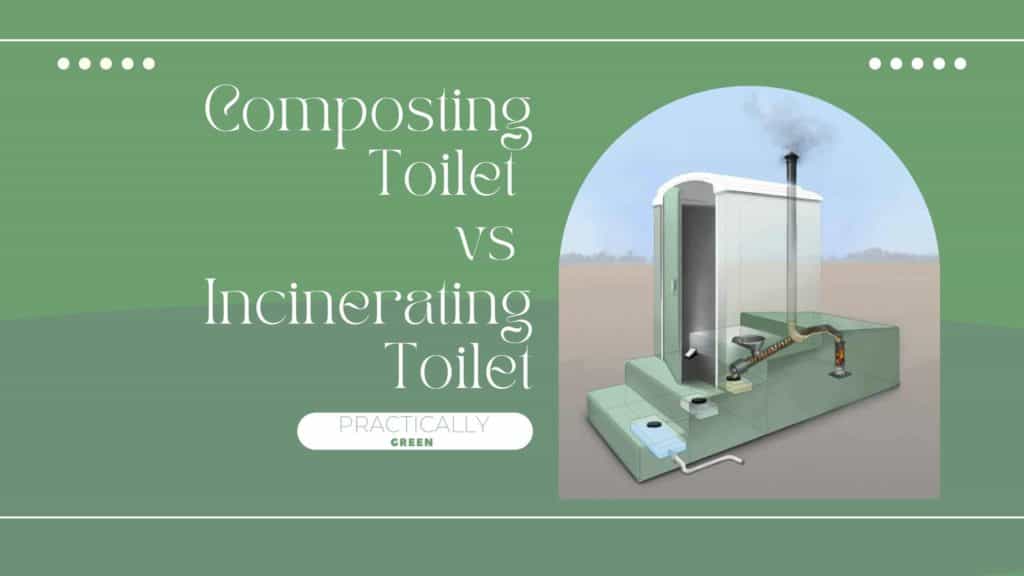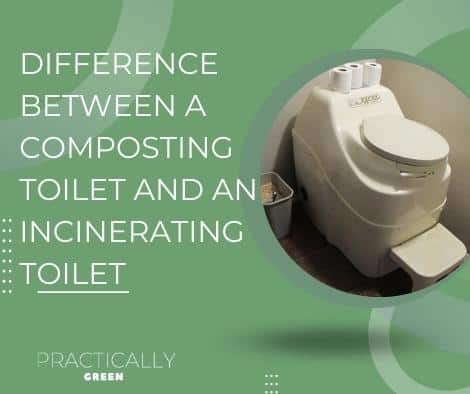Composting Toilet vs Incinerating Toilet

The kind of toilet you pick for your house will have a long-term impact on how you use the bathroom, so don’t make this decision carelessly.
For many, this boils down to a choice between one of the many types of composting toilets, and an incinerating toilet.
To choose the optimal toilet for your residence, you must first understand how composting and incinerating toilets operate, as well as the distinctions between them.
In this article, we discuss composting toilets vs incinerating toilets and the benefits and drawbacks of both incinerating and composting toilets, equipping you with all the information you need to make the best choice for yourself and the environment.
What is the difference between a composting toilet and an incinerating toilet?

These days, the best composting toilets are a popular solution for more ecologically friendly toilet arrangements. These toilets allow households to break down their waste organically through decomposition.
After the material has decomposed it may be utilized as compost, thus killing two birds with one stone.
A composting toilet looks like any other type of household restroom with the exception that it does not use water to flush.
Instead, as you’re using the bathroom and sitting on a plastic seat or ceramic bowl, you’ll see an opening at the bottom where your waste is deposited into.
A further popular alternative is an incinerating toilet, which actively eliminates your waste by incinerating it right after you use the facility.
This toilet does not flush your waste; alternatively, it burns it!
Incinerating toilets are much more common in large buildings such as office spaces because they do away with most if not all of their sanitary issues by incineration.
The incineration process happens through the use of a burning chamber that’s lined with insulation made from materials like wool, felt, or stone.
Incinerating Vs Composting:
Composting toilets and Incinerating toilets each have different functions, costs, electricity use, eco-friendly aspects, convenience, cleanliness, capacity, and disposal.
Knowing these differences is crucial in making a well-informed decision on which would be a better system for you and your household.
Function

A composting toilet uses a natural composting process to break down and burn waste material into safe, stable, and affordable fertilizer for gardens.
This is in comparison to the incinerating system which uses electric heat to burn and break down human waste into a harmless by-product.
Cost

The composting system is far more cost-friendly than the incinerator toilet.
With composting toilets ranging from $875 up to $3000, and incinerating toilets ranging between $1200 all the way up to $4000.
A composting toilet tends to be cheaper than an incinerating toilet because of the required water usage with composting systems- these systems can require no water at all, making it perfect for dry climates.
They also produce some heat as well which will save energy if you’re going off-grid!
Electricity

There is a wider range of composting toilets in comparison to incinerating, this is because there are both electric and non-electric models available to choose from.
This means that if you live somewhere with low or no electricity supplies, you can still install a composting system.
A septic system on the other hand, such as the incinerator, requires consistent power for use (roughly 1.5-2 KW hours of electricity per cycle use).
This would mean you have to take into consideration the electricity supplies in your living space, before installing an incinerating system.
Eco-friendly?

Both incinerating toilets and composting toilets are eco-friendly options, but there is a major difference between the two.
Incinerating toilets require water to operate so it’s not as much of an option in areas where water resources are scarce. But if you live in a place that has access to plenty of rainwater or dependable electricity then they’re great for keeping your toilet hygienic.
Composting on the other hand doesn’t need any type of liquid (although some people will use manure from animals) which makes them more efficient when using non-renewable resources like wood chips or peat moss!
Incinerators also release carbon dioxide emissions into the atmosphere which can be harmful to the climate, whilst composters don’t.
As well as requiring consistent electric power usage, incinerating toilets also need paper bowl liners.
Composting toilets produce compost to keep natural waste circulating through, all while not requiring power usage.
This makes the composting system a more environmentally friendly option.
Convenience
When it comes down to convenience, composters require you to use an external hand crank to stir the solid waste and peat moss after each use, however, they’re more portable than incinerators.
Incinerators, on the other hand, are much more low maintenance in the sense that once installed, they don’t require further action, other than when emptying out the chamber.
Incinerating the toilet will take up space in your RV, cabin, garage, or home so it’s not as practical for those who live in smaller living spaces – unless you’re willing to put on a little more effort!
Cleanliness
In terms of cleanliness, liquid and solid waste from composting toilets can stain the pot’s surface. For compostable materials, it’s necessary to remove the waste from the toilet and transfer it onto farmland for conversion.
Incinerating toilets are cleaner than composting toilets because they don’t require post-processing; the waste doesn’t actually touch the pot surface.
Capacity
The composting toilet by far has a much larger volume as compared to an incinerating toilet.
This is because a composting toilet can go between 1 to 6 months without the need for it to be emptied.
Incinerating toilets require more frequent emptying and can even be as frequent as needing to be emptied once a day.
In terms of water usage, both types of toilets try to reduce water usage by using gravity instead so you won’t need nearly as much water when flushing either one.
Incinerators use about 25 gallons while composters use just over 17 gallons.
Disposal
A composting toilet separates liquid from solid waste and can reuse solid waste to fertilize flowers and trees.
However, the ash from incinerating toilets is not reusable but can be simply tossed in your trash.
Do incinerating and composting toilets smell?
One of the biggest concerns people have with eco and environmentally friendly toilets is the odor.
A large number of people will avoid making that step into sustainable living due to the fear of having constant bad odor in their residence.
What many fail to realize is that with just a little research, they can find many odorless models that are available.
Don’t let the fear of a bad smell stop you from living more sustainably!
How much propane does an incinerating toilet use?
An incinerator uses a lot more propane than most people would like to imagine: they will consume anywhere between 45-55 kilowatts every hour depending on how often it is used.
You will get an average of 75 to 100 incineration cycles on one 20lb (11kg) propane bottle.
Pros and Cons:

Composting toilet:
Pros:
- Composting toilets use a fraction of the energy that incinerators do
- They are environmentally friendly and help reduce greenhouse gasses by decomposing waste into the soil in just days instead of years
Cons:
- Not all composting toilet designs are odorless which may be necessary for your situation
Incinerating toilet
Pros:
- Incinerating toilets create a lot of heat which can be used to provide warmth and power appliances
- Easy to install and maintain
Cons:
- The incineration process can sometimes produce harmful substances like dioxins, which could be harmful to the environment
Conclusion
As you can see, the primary components of a composting toilet are all constructed with a single goal in mind: to provide a dry environment for solid waste, allowing the waste breakdown process to take place, whereas incinerating toilets are intended for ease and cleanliness.
It’s possible to mix up incinerating toilets with normal bathroom toilets since they appear so similar.
A composting toilet like a Separett Villa is better at preserving natural gas and resources than incinerators. They also have a lower environmental footprint and produce fewer greenhouse gases because the waste is composted, not burned.
Incinerators release carbon dioxide as well as nitrogen oxide into the atmosphere, often in large quantities; these are both pollutants that contribute to air pollution which can be harmful to those who breathe it.
The best choice to make for your home depends entirely on what you’re looking for whilst many are content with incinerating or composting toilets, some decide to opt for alternatives such as dry flush toilets or Electric toilets.
Use this article as a part of your research into finding the best solution for your home.
A quick search of questions you may have will likely solve your queries and prepare you for making a more well-informed decision.

